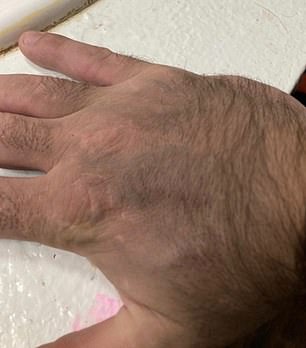Doctors warn against popular plant supplement that turns people's skin BLUE and is linked to spate of deaths
Doctors are warning Americans about the health effects of an increasingly popular supplement linked to a spate of deaths — which can also change the color of someone's skin.
Kratom first became popular in the US as an opioid withdrawal treatment, but more recently has gained ground as a wellness supplement for anxiety and stress.
But the plant leaf extract — sold in wellness stores and gas stations for about 20 cents per pill— has been linked to a range of serious side-effects, including seizures, hallucinations and crippling addiction.
Several deaths from taking the supplement have also been reported.
Now, doctors are again warning that it can also alter the hue of a patients' skin after spotting an uptick in cases. They say this color change can persist for months, even when someone stops taking the supplement.

Pictured above is the 30-year-old patient who came to doctors in Kansas with blue skin after taking Kratom. The symptoms did not resolve 16 months later


He also had blue-colored skin on the back of his hand and the area on the back of his neck. It is not clear how Kratom may cause this
Among those affected is a 30-year-old man who came to doctors in Kansas with dark gray-blue skin on his cheeks, back of his neck, and the backs of his hands and forearms.
The patient had taken Kratom for five years, and had no problems until his skin suddenly changed color. Sixteen months after quitting the supplement it is still blue.
He had started taking Kratom daily to help ease an opioid addiction that he developed after high school.
Dr Heather Woolery-Lloyd, a dermatologist at the University of Miami, said in an interview with Medscape: 'This is something we will see more and more.
'Many of our patients think Kratom is a safe, herbal supplement, but often don't know it can have several side effects and can be addictive.'
The supplement is made from the leaves of the South East Asian rainforest tree of the same name, and has been in use in cultures in Cambodia, Thailand and elsewhere since at least the 19th century.
It can be boiled into a tea, smoked, chewed, mixed into drinks or placed into capsules, with many taking Kratom daily to help them quit opioids.
The FDA warns against taking the supplement, saying it has not been approved for any use in the US.

This image also shows the patient with the blue skin on the side of his face, which did not disappear

The above patient in Washington state also came to doctors saying their skin had turned blue after taking the supplement
But data suggests that use of the supplement — which has also been called a 'legal opioid' and 'legal high' online — is continuing to increase.
Data from the United States National Poison Data System showed there were just 11 poisonings with Kratom reported in 2011.
But in the first seven months of 2018 alone, this figure had spiraled to 357 cases.
A study in 2021 estimated that 1.7million Americans were taking the supplement — partially to help ease opioid addictions.
Drugs including methadone and naltrexone are used to treat opioid addiction, but these can have side-effects like constipation, headaches, sweating and insomnia — prompting many to seek alternatives.
It isn't clear why Kratom may turn someone's skin blue, but scientists have previously suggested it may be linked to the supplement raising dopamine levels, which can boost melanin production — which may cause thicker patches of color to appear.
It could also be linked to the supplement causing deposits around blood vessels, which may cause the blue patches — or any impurities in the supplement.
The blue skin has only appeared on areas exposed to sunlight, which also has a link to increased melanin production.
This differs from the blue skin caused in a condition called cyanosis, which is when a lack of oxygen in the blood causes it to change color.
In a case revealed in February this year involving a 30-year-old man who came to doctors in Kansas, the patient said he started using Kratom to help with an opioid addiction.
He took Kratom for four-and-a-half years before the discoloration occurred, telling doctors that it had appeared rapidly.
He started to take Kratom for an opioid addiction, and did not have any other medical conditions and did not take any other drugs or supplements that could have caused the blue skin to emerge.
In another case from 2022, a 54-year-old man who came to doctors in Washington state also revealed his skin had turned blue while taking Kratom.
He said the color had appeared slowly on both his arms and face in areas exposed to sunlight.
He had also been taking Kratom with orange juice three to four times a day for five years to help with his opioid addiction.
The Drug Enforcement Administration (DEA) suggested banning Kratom in 2017 and listing it as a Schedule I substance alongside heroin, marijuana and LSD.
But these plans were later abandoned following widespread protestes over the move in many US cities.
An estimated 2.1million Americans are currently struggling with an opioid addiction.







































































































































































































































































































































































































